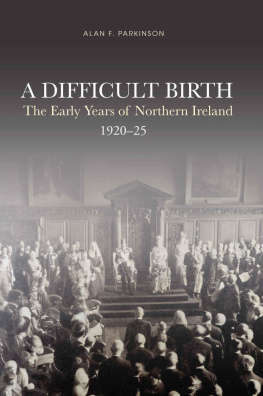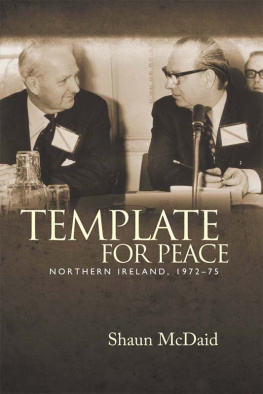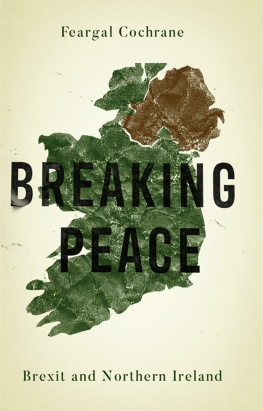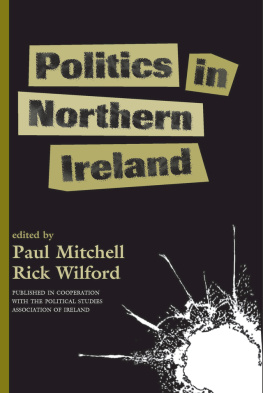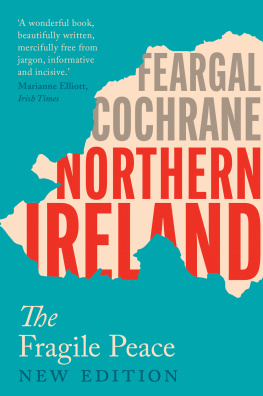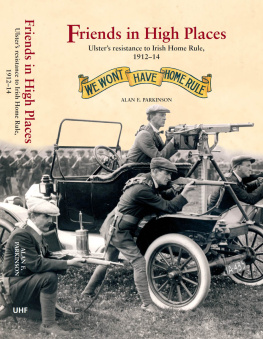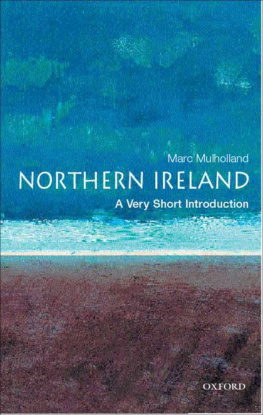A DIFFICULT BIRTH
A DIFFICULT BIRTH
The Early Years of Northern Ireland, 19205
Alan F. Parkinson

In memory of D. George Boyce (19422020), an outstanding historian and kind mentor.
First published by Eastwood Books, 2020
Dublin, Ireland
www.eastwoodbooks.com
www.wordwellbooks.com
@eastwoodbooks
First Edition
Eastwood Books is an imprint of the Wordwell Group
Eastwood Books
The Wordwell Group
Unit 9, 78 Furze Road
Sandyford
Dublin, Ireland
Alan F. Parkinson
ISBN 978-1-8380416-2-5 (paperback)
ISBN 978-1-913934-02-6 (mobi)
ISBN 978-1-913934-03-3 (epub)
The right of Alan F. Parkinson to be identified as the author of this work has been asserted in accordance with the Copyright and Related Rights Act, 2000.
All rights reserved. No part of this book may be reprinted or reproduced or utilised in any form or by any electronic, mechanical or other means, now known or hereafter invented, including photocopying and recording, or in any information storage or retrieval system, without the permission in writing of the publishers.
British Library Cataloguing in Publication Data.
A catalogue record for this book is available from the British Library.
Typeset in ITC New Baskerville by Wordwell Ltd, Dublin.
Copy-editor: Emer Condit
Cover design and artwork: Ronan Colgan
Printed by: Sprint Print, Dublin
Contents
Acknowledgements
Photos: back cover, 1, 311, 1519, 212, 24, 26, 29 and 30 all courtesy of the Belfast Telegraph.
Photos: back cover, 1213, 23 and 25 by permission of the Deputy Keeper of the Records, PRONI.
Photos 14, 20 and 28 appeared in The Graphic magazine.
Photo 2 courtesy of the Irish Linen Centre/Lisburn Museum (particular thanks to Ciaran Toal).
Abbreviations
AOH | Ancient Order of Hibernians |
BPA | Belfast Protestant Association |
DUP | Democratic Unionist Party |
IRA | Irish Republican Army |
IRB | Irish Republican Brotherhood |
NICRA | Northern Ireland Civil Rights Association |
PIRA | Provisional Irish Republican Army |
PRONI | Public Record Office of Northern Ireland |
RIC | Royal Irish Constabulary |
RUC | Royal Ulster Constabulary |
SDLP | Social Democratic & Labour Party |
UDR | Ulster Defence Regiment |
UIL | United Irish League |
UPA | Ulster Protestant Association |
USC | Ulster Special Constabulary |
UTDA | Ulster Traders Defence Association |
UUC | Ulster Unionist Council |
UULA | Ulster Unionist Labour Association |
UUP | Ulster Unionist Party |
Preface
To a large degree, the circumstances behind the monumental political and constitutional developments in the north of Ireland between 1920 and 1922 have rarely been the subject of in-depth analysis by historians, whilst the violence which accompanied this major change has often been interpreted in a restrictive, one-dimensional manner. Dismissed by some as a pogrom and as the Norths highly distinctive version of the wider Irish war of the time, sceptics have interpreted the Twenties Troubles and the formative years of the Northern Irish state as a story of rampant sectarianism, State-sponsored butchery and even ethnic cleansing, all ignored by a partisan government in Belfast. Less attention has been paid to the role of the IRA in fermenting such discord, the influence of events south of the newly established border (particularly the imposition of economic sanctions on Northern Ireland) and the profound problems encountered both by the regions political leaders and by its ordinary Protestant and Catholic citizens during the turbulent years which coincided with its infancy. More perceptive observers, however, have drawn our attention to the sheer inevitability of civil unrest and imminent political upheaval in Ulster during the immediate post-war years, and how the tinderbox nature of its society meant that the North was a sectarian time-bomb ready to be detonated by agitation.
Until my book Belfasts Unholy War was published in 2004, there had been few works specifically about this subject. Those books that have emerged during the last twenty years or so have predominantly looked at the period from the perspective of some people who were participants, reluctantly or otherwise, in the conflict. Therefore a number of books, usually written by relatives of the deceased, have looked at the 1920s northern conflict through the eyes of republican activists, or through the recollections of former RIC officers. Some writers have alluded to how the patterns of the 1920s disturbances (especially those in Belfast) contrasted sharply with those of previous riots, in terms not only of their degree of intensity but also of their extended, if intermittent, nature. Other observers have, perhaps somewhat simplistically, explained the disturbances and the regions weak governance as being the sole responsibility of the unionist administration, but more discerning commentators have suggested that events in Northern Ireland, whilst they appeared to sustain their own momentum, were clearly conditioned by events occurring elsewhere on the island, which were beyond the control of any administration based in its northern capital.
What makes this apparent oversight of such a pivotal period in Northern Irelands history so surprising is that the events of these years proved to be highly significant in determining the subsequent attitudes of political and religious leaders of both sections of the community. The effects of the Twenties Troubles on the psyche of both Protestants and Catholics were also profound. Unionist awareness of the vulnerability of their recently won territory was heightened by the IRAs campaigns in cities like Derry and Belfast as well as along the border areas, and loyalists keenly endorsed the safety first measures championed by their political leaders. In doing so, they willingly accepted these exhortations to maintain the political status quo, not only in the immediate aftermath of these Troubles but also for several decades afterwards. Catholics early mistrust of the unionist administrations lethargic response to loyalist terrorism was hard to alter once the violence subsided. In other words, the communal suffering engendered during these dismal times created a lasting atmosphere of fear and mistrust, and provoked responses of non-cooperation which endured for close to half a century, proving to be the catalyst for the next bout of sectarian disturbances that would start to blight Belfast and Northern Ireland from the end of the 1960s.
Why, then, given their undoubted significance, have the 1920s Ulster Troubles and the birth of Northern Ireland warranted relatively little analytical research? On a practical level, some historians are deterred by conflicting contemporary newspaper reports, the incomplete and often inaccurate nature of police and army reports, and the difficulties in accessing some government records. Others have probably been put off by the bleak picture that has been painted of this short periodone of a bloody, gloomy and nihilistic episode in modern Irish history. Apart from filling such a gap, a detailed study of this subject is also chronologically appropriate. The centenary of the start of the northern disturbances and the opening of Northern Irelands first parliament is nearly upon us. This landmark is, of course, only the latest anniversary in a host of major events that occurred across Ireland within a relatively short time-frame approximately one hundred years ago, and it is essential to place it within the context of this decade of centenaries. Some northerners believe that the birth of the Northern Ireland state represents the single most important of all these momentous events during this decade and that it has been conspicuously downplayed, especially when compared to the huge amount of coverage lavished on the centenary of the Dublin Rising in 2016.
Next page
